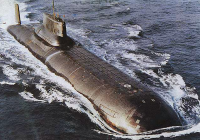








A submarine is a watercraft capable of independent operation underwater. It differs from a submersible, which has more limited underwater capability.
Although experimental submarines had been built before, submarine design took off during the 19th century, and they were adopted by several navies. Submarines were first widely used during World War I (1914–1918), and now figure in many navies large and small. Military usage includes attacking enemy surface ships (merchant and military), submarines, aircraft carrier protection, blockade running, ballistic missile submarines as part of a nuclear strike force, reconnaissance, conventional land attack (for example using a cruise missile), and covert insertion of special forces. Civilian uses for submarines include marine science, salvage, exploration and facility inspection/maintenance. Submarines can also be modified to perform more specialized functions such as search-and-rescue missions or undersea cable repair. Submarines are also used in tourism, and for undersea archaeology.
Most large submarines consist of a cylindrical body with hemispherical (and/or conical) ends and a vertical structure, usually located amidships, which houses communications and sensing devices as well as periscopes. In modern submarines, this structure is the "sail" in American usage, and "fin" in European usage. A "conning tower" was a feature of earlier designs: a separate pressure hull above the main body of the boat that allowed the use of shorter periscopes. There is a propeller (or pump jet) at the rear, and various hydrodynamic control fins. Smaller, deep diving and specialty submarines may deviate significantly from this traditional layout. Submarines change the amount of water and air in their ballast tanks to decrease buoyancy for submerging or increase it for surfacing.
Submarines have one of the widest ranges of types and capabilities of any vessel. They range from small autonomous examples and one or two-person vessels that operate for a few hours, to vessels that can remain submerged for six months—such as the Russian Typhoon class, the biggest submarines ever built. Submarines can work at greater depths than are survivable or practical for human divers.Modern deep-diving submarines derive from the bathyscaphe, which in turn evolved from the diving bell.
History
Early submersibles
In 1797,Robert Fulton (1765-1815),a Pennsylvania born artist and inventor ,offered to built a asubmarine for the french,who were then engaged in a bitter war with Britain.He proposed to use the vessel to sink Royal Navy Warships blockading french ports.The french government hesitated to become involved in what they regarded as a dishonorable style of warfare.Undeterred,Fulton went ahead with developing his machine,gaining french financial backing after Napoleon made himself Firast Consul in 1799.
According to a report attributed to Tahbir al-Tayseer in Opusculum Taisnieri published in 1562:
Two Greeks submerged and surfaced in the river Tagus near the City of Toledo several times in the presence of The Holy Roman Emperor Charles V, without getting wet and with the flame they carried in their hands still alight.
It is claimed that Cosme García Sáez produced a viable submersible design predating those of Isaac Peral and Narciso Monturiol.
The first submersible of whose construction there exists reliable information was built in 1620 by Cornelius Drebbel, a Dutchman in the service of James I of England. It was created to the standards of the design outlined by English mathematician William Bourne.It was propelled by means of oars. The precise nature of the submarine type is a matter of some controversy; some claim that it was merely a bell towed by a boat.
By the mid-18th century, over a dozen patents for submarines/submersible boats had been granted in England. In 1747, Nathaniel Symons patented and built the first known working example of the use of a ballast tank for submersion. His design used leather bags that could fill with water to submerge the craft. A mechanism was used to twist the water out of the bags and cause the boat to resurface. In 1749, the Gentlemen's Magazine reported that a similar design had initially been proposed by Giovanni Borelli in 1680. By this point of development, further improvement in design necessarily stagnated for over a century, until new industrial technologies for propulsion and stability could be applied.
The first military submarine was the Turtle (1775), a hand-powered acorn-shaped device designed by the American David Bushnell to accommodate a single person.It was the first verified submarine capable of independent underwater operation and movement, and the first to use screws for propulsion.In 1800, France built a human-powered submarine designed by American Robert Fulton, the Nautilus. The French eventually gave up on the experiment in 1804, as did the British when they later considered Fulton's submarine design.
In 1864, the fourth year of the American Civil War, the Confederate navy's H. L. Hunley became the first military submarine to sink an enemy vessel, the Union sloop-of-war USS Housatonic. In the aftermath of its successful attack against the ship, the Hunley also sank, possibly due to its being too close to its own exploding torpedo.